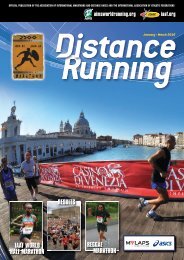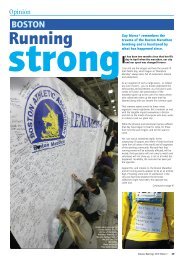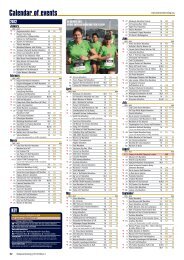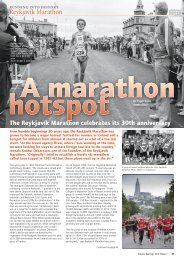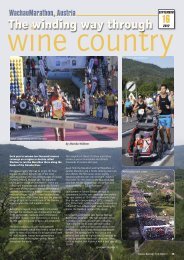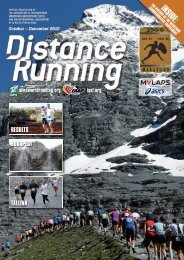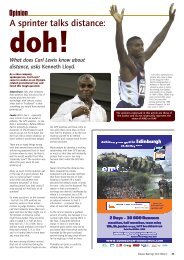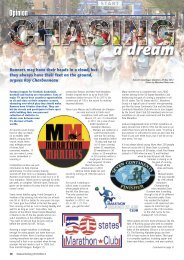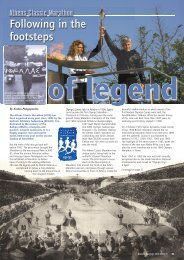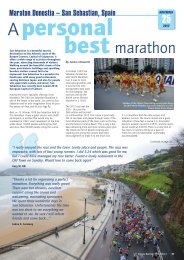Download pdf - Distance Running magazine
Download pdf - Distance Running magazine
Download pdf - Distance Running magazine
Create successful ePaper yourself
Turn your PDF publications into a flip-book with our unique Google optimized e-Paper software.
From then to now<br />
The marathon is a huge public<br />
festival which takes over the<br />
streets, but a generation ago it was<br />
for a few dozen obsessives battling<br />
with traffic on backroads. How did<br />
we get from then to now?*<br />
Marathons today are major earners:<br />
for the top runners of course - but<br />
also for tour operators, hotels, and<br />
airlines. Sponsors compete to use<br />
these public events as vehicles for<br />
promotion. Charities recruit teams<br />
of runners to raise funds through<br />
sponsorship.<br />
Yet marathon running 30 years ago<br />
was hardly known. It was a<br />
competitive sport that took place<br />
on the open road in which even the<br />
top performers went financially<br />
unrewarded.<br />
Boston Marathon, the most wellknown<br />
race in the world. A headto-head<br />
competition between two<br />
American runners – both of them<br />
among the best in the world - is a<br />
distant dream nowadays, but in<br />
1976 it was what launched the<br />
Marathon.<br />
Entries poured in. They were<br />
capped at 2100. Lebow’s account of<br />
that first City marathon makes<br />
clear what an adventurous gamble<br />
it was. What is taken for granted<br />
today was unknown, or uncertain.<br />
Would traffic restrictions be<br />
enforceable? Would volunteers<br />
show up? Would bystanders respect<br />
the course? And would all those<br />
runners, half doing it for the very<br />
first time, actually enjoy it? They<br />
did. It was a resounding success.<br />
Fred Lebow’s first New York City<br />
Marathon, in 1970, was no<br />
different to any other marathon of<br />
the time. It was confined to laps of<br />
Central Park; it was put together on<br />
an extremely limited budget; and it<br />
had only 55 finishers. In 1972<br />
Frank Shorter won the Olympic<br />
Marathon and the American public<br />
slowly became aware of the<br />
Marathon, but the field continued<br />
to grow only slowly.<br />
The 1976 race changed all that.<br />
Almost by accident, it broke the<br />
mould of all previous marathon<br />
races. Ted Corbitt, a pioneer of<br />
road race measurement and himself<br />
a notable runner, suggested inviting<br />
teams from the five boroughs of<br />
New York City to compete in the<br />
race. Somehow this was understood<br />
by the City as a proposal to run the<br />
race route through the five<br />
boroughs, and they liked the idea.<br />
Lebow was opposed: “You couldn’t<br />
run a marathon through city streets.<br />
Even the Boston Marathon, the<br />
oldest and most prestigious, only<br />
ran the last few miles in Boston<br />
itself.” Lebow thought that it<br />
would be too expensive to organise<br />
and impossible to get all the<br />
permissions. The American<br />
Bicentennial fell in 1976 and people<br />
in the Mayor’s office thought that a<br />
citywide five-borough marathon<br />
would be a good way to celebrate<br />
the occasion. They secured a<br />
sponsor and the Mayor’s full<br />
support. “The first reaction of the<br />
Police Department was “No Way!”<br />
But the city insisted, and the Police<br />
had to go along with it.”<br />
To capture public interest Lebow<br />
head hunted top-name athletes.<br />
Frank Shorter had just won a silver<br />
medal in the Montreal Olympics.<br />
Bill Rodgers had twice won the<br />
The following year there were 5000<br />
runners and for its 1979 edition the<br />
New York City Marathon accepted<br />
14,000 entries, a seven-fold increase<br />
in three years. Yet even this wasn’t<br />
enough to meet the demand. One of<br />
the entrants was Chris Brasher<br />
who, spellbound by the experience,<br />
resolved to put on something<br />
similar in London.<br />
What had been born on the streets<br />
of New York quickly attracted<br />
emulation. The Berlin Marathon,<br />
founded four years after New York,<br />
moved out of the Grunewald woods<br />
and on to the streets of the city in<br />
1980. The following year Chris<br />
Brasher inaugurated the London<br />
Marathon. Suddenly, no major city<br />
in the world was complete without<br />
its own marathon.<br />
In founding the London Marathon<br />
Chris Brasher cited, among his<br />
objectives, “to provide happiness<br />
and a sense of achievement.” It was<br />
this which explained the runaway<br />
success of the marathon. In London<br />
20,000 people wanted to run and<br />
7,000 were accepted. The following<br />
year, when the race coincided with<br />
the foundation of AIMS, 90,000<br />
people applied to run and 18,000<br />
were accepted.<br />
Fred Lebow was there. He<br />
generously acknowledged London’s<br />
ascendancy. But it was he who had<br />
laid the foundations of the<br />
Marathon movement as we have<br />
known it for the last 30 years. Fred<br />
Lebow’s experience in setting up the<br />
world’s original mass marathon<br />
provided a template for those who<br />
came later.<br />
What New York had done was<br />
tackled by all the other events that<br />
followed. The struggle to stage a<br />
controlled start. The detail of how<br />
to guide runners smoothly around<br />
the course. How to keep the finish<br />
line free of obstructions. How to<br />
give the best possible view of it all<br />
for the onlookers and media.<br />
Conceptually these are simple<br />
problems but become complicated<br />
because they take place in the real<br />
world. Compared to the<br />
choreographed environment of an<br />
athletic stadium, Marathons looked<br />
chaotic. “In those days, road<br />
racing was treated like the bastard<br />
offspring of track and field” said<br />
Lebow.<br />
But a firm anchor in the real world<br />
was always the strength of the<br />
reborn sport. The streets are not a<br />
stage for selected actors to perform.<br />
They are up for grabs. Anyone can<br />
come and have a go. And come<br />
they did. Like Chris Brasher, at first<br />
dozens but eventually thousands of<br />
British runners crossed the Atlantic<br />
just to run in the New York City<br />
Marathon.<br />
Britain was no special case. In<br />
France, Italy, Germany, Spain,<br />
Mexico, Brazil, and many other<br />
countries, runners wanted to go to<br />
New York. Usually they stayed for<br />
a week. Demand increased, hotels<br />
put up their prices and a lot of<br />
money was made.<br />
Fred Lebow may not have seen this<br />
ahead of time, but he seized the<br />
opportunity. New York became the<br />
most international of marathons. It<br />
pioneered the trade in running<br />
tourism which was continued<br />
through AIMS. New York’s success<br />
demonstrated the pressing need for<br />
an organisation like AIMS, for at<br />
least two reasons. The first was to<br />
set some basic rules. Marathons<br />
had to be marathons, 42,195m<br />
long. Other standards also applied,<br />
but with less certainty. They could<br />
best be encouraged by offering<br />
advice and help, and AIMS was<br />
well placed to assist.<br />
AIMS also offered an ideal channel<br />
through which to promote running<br />
tourism. This was the most valuable<br />
card a race could play to its city<br />
authorities, to national government,<br />
to media outlets and to business<br />
interests both local and national. In<br />
most places it was the key<br />
consideration in getting a race onto<br />
the road.<br />
Since AIMS’ foundation, 25 years<br />
ago, membership has mushroomed<br />
to approach 250 events. AIMS’ very<br />
existence is part of that recipe for<br />
success. It is a global enterprise. We<br />
have the same interests but we<br />
come from very different places. As<br />
Chris Brasher said, the Marathon<br />
can “show to mankind that, on<br />
occasions, they can be united”.<br />
There can be no greater<br />
achievement.<br />
* This is an edited version of an<br />
address given to the 1st AIMS<br />
Marathon Symposium, held on 3<br />
November 2007, by AIMS<br />
Secretary Hugh Jones.<br />
THE OPINIONS EXPRESSED IN<br />
THIS ARTICLE ARE THOSE OF THE<br />
AUTHOR AND DO NOT<br />
NECCESSARILY REPRESENT THE<br />
VIEWS OF AIMS OR IAAF<br />
40 <strong>Distance</strong> <strong>Running</strong> January – March 2008



